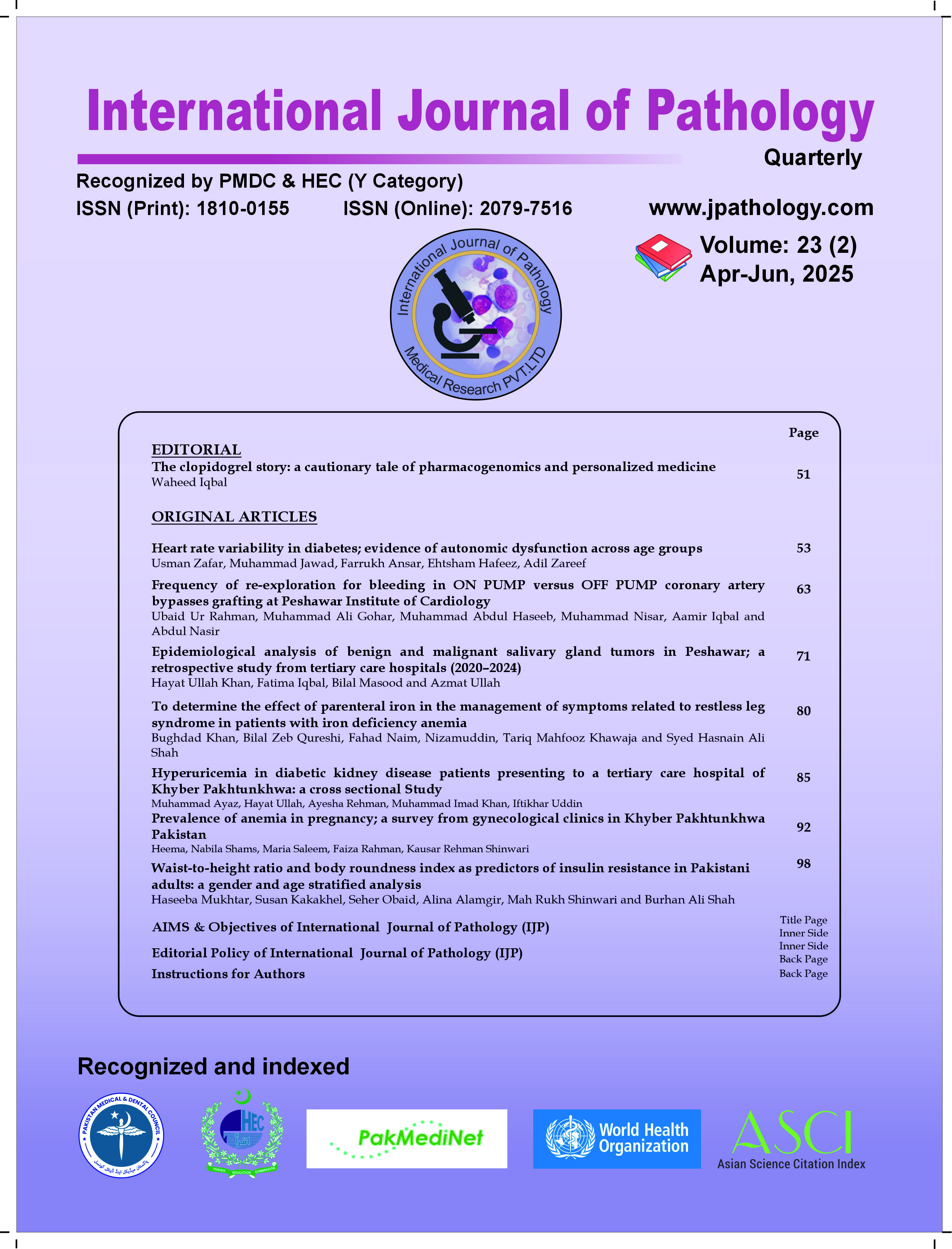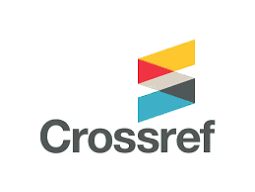Waist-to-height ratio and body roundness index as predictors of insulin resistance in Pakistani adults
a gender and age stratified analysis
DOI:
https://doi.org/10.59736/IJP.23.02.959Keywords:
Insulin Resistance, Metabolic Syndrome, Obesity, Risk Assessment, Waist-Height RatioAbstract
Background: A major risk factor for metabolic syndrome and type 2 diabetes mellitus (T2DM), insulin resistance (IR) is especially common in South Asian populations. One of the main causes of IR, central adiposity, is not well represented by traditional anthropometric measures such as the body mass index (BMI) and waist-to-hip ratio (WHR). Using gender- and age-stratified analyses, this study examines the diagnostic value of the Waist-to-Height Ratio (WtHR) and Body Roundness Index (BRI) in predicting IR in Pakistani adults.
Methods: In this cross-sectional study, 1,592 adults aged 18–70 years were recruited from tertiary care hospitals in Peshawar, Pakistan. IR was defined with a threshold of >2.5 using the Homeostasis Model Assessment of Insulin Resistance (HOMA-IR). WtHR, BRI, BMI, WHR, and Abdominal Volume Index (AVI) were calculated using anthropometric data (height, weight, and waist circumference). Youden Index (J) and Receiver Operating Characteristic (ROC) curves were used to assess diagnostic performance, with subgroup analysis by age (≥60 years vs. ≥60 years) and gender.
Results: WtHR showed the highest area under the curve (AUC = 0.710), followed by BRI (AUC = 0.707). The optimal cut-off for WtHR (0.54) achieved 71% sensitivity and 69% specificity (J = 0.40), while BRI (cut-off: 4.2) yielded 69% sensitivity and 68% specificity (J = 0.37).
Conclusion: WtHR and BRI are better at predicting insulin resistance than traditional indices, especially in younger and female populations. In resource limited environments, such as Pakistan, their non-invasive nature and ease of use make them useful instruments for early IR screening.
References
REFERENCES
Basit A, Fawwad A, Siddiqui SA, Baqa K. Prevalence of diabetes, prediabetes and associated risk factors: Second National Diabetes Survey of Pakistan (NDSP) 2016–2017. BMJ Open. 2021;11(3):e042125.
DOI: 10.1136/bmjopen-2017-020961
URL: https://bmjopen.bmj.com/content/8/8/e020961
Abdul Basith Khan, M., Hashim, M.J., King, J.K. et al. Epidemiology of Type 2 Diabetes — Global Burden of Disease and Forecasted Trends. J Epidemiol Glob Health 10, 107–111 (2020).
https://doi.org/10.2991/jegh.k.191028.001
Rasool N, Balouch AW, Khan RT, Akbar N, Sanjani SR, Haq MM, Ismail H, Majid Z, Nasir A, Luck NH. Prediction of Non-Alcoholic Fatty Liver Disease (NAFLD) in Both Lean and Obese Patients Utilizing the Waist to Height Ratio (WHR) and Fatty Liver Index (FLI). Journal of Health and Rehabilitation Research. 2024 Apr 15;4(2):84-9.
https://doi.org/10.61919/jhrr.v4i2.734
Li YM, Zou ZY, Hua Y, Luo JY, Jing J, Zhang X, Luo CY, Wang H, Zhao HP, Pan DH, Luo MY. Predicting metabolic syndrome using anthropometric indices among chinese adolescents with different nutritional status: A multicenter cross-sectional study. Biomedical and Environmental Sciences. 2021 Sep 1;34(9):673-82.
https://doi.org/10.3967/bes2021.095
Park J, Byun Y, Kim S. Predictive Diagnostic Power of Anthropometric Indicators for Metabolic Syndrome: A Comparative Study in Korean Adults. Journal of Clinical Medicine. 2025 Jan 12;14(2):448.
https://doi.org/10.3390/jcm14020448
Jayawardena R, Sooriyaarachchi P, Misra A. Abdominal obesity and metabolic syndrome in South Asians: prevention and management. Expert Review of Endocrinology & Metabolism. 2021 Nov 2;16(6):339-49.
https://doi.org/10.1080/17446651.2021.1982381
Ashwell M, Gibson S. Waist-to-height ratio as a screening tool for adiposity and cardiometabolic ri. 2021;29(4):118-124.
Li Z, Liu X, Peng Y, et al. Waist to height ratio and Body Roundness Index: superior predictors of insulin resistance in Chinese adults considering gender and age. Front Nutr. 2024;11:1480707.
Murai N, Saito N, Oka R, et al. Body Roundness Index correlates better with insulin sensitivity than Body Shape Index in young and middle-aged Japanese persons. Metab Syndr Relat Disord. 2024;22(2):151 159.
Adil SO, Musa KI, Uddin F, et al. Anthropometric indices as screening tools for metabolic syndrome among apparently healthy adults in Karachi, Pakistan. Front Endocrinol. 2023;14:1223424.
Rico Martín S, Calderón García JF, Sánchez Rey P, et al. Effectiveness of Body Roundness Index in predicting metabolic syndrome: a systematic review and meta analysis. Obes Rev. 2020;21(7):e13023.
Lan Y, Zhong C, Li D, et al. Association between waist to height ratio and insulin resistance in patients with polycystic ovary syndrome: a meta analysis. Front Endocrinol (Lausanne). 2025;16:1567787.
Hsu YW, Tsai PS, Liu YW, et al. Gender differences in abdominal obesity and insulin resistance in young adults. J Clin Endocrinol Metab. 2020;105(7):1955 1964.
Chan V, Cao L, Wong MMH, et al. Diagnostic accuracy of waist to height ratio, waist circumference and BMI for metabolic syndrome in older adults: systematic review and meta analysis. Curr Dev Nutr. 2024;8:102061.
Moosaie F, Fatemi Abhari SM, Deravi N, Karimi Behnagh A, Esteghamati S, Dehghani Firouzabadi F, Rabizadeh S, Nakhjavani M, Esteghamati A. Waist-to-height ratio is a more accurate tool for predicting hypertension than waist-to-hip circumference and BMI in patients with type 2 diabetes: a prospective study. Frontiers in public health. 2021 Oct 7;9:726288.
Azevedo VZ, Ponnaiah M, Lassen PB, Ratziu V, Oppert JM. A diagnostic proposal for sarcopenic obesity in adults based on body composition phenotypes. Clinical Nutrition ESPEN. 2022 Dec 1;52:119-30.
Xu J, Zhang L, Wu Q, et al. Body Roundness Index is a superior indicator of cardiometabolic risk: evidence from a cross sectional study of 17,000 adults in Eastern China. BMC Cardiovasc Disord. 2021;21:97.
Abid F, Irfan M, Ali Z, Fatima U. Body Shape Index, Body Adiposity Index, and Body Roundness Index to Predict Cardiovascular Health Status. Pakistan Journal of Medicine and Dentistry. 2022;11(4):55-60.
Downloads
Published
Issue
Section
License
Copyright (c) 2025 Haseeba Mukhtar, Susan Kakakhel, Seher Obaid, Alina Alamgir, Mah Rukh Shinwari, Burhan Ali Shah

This work is licensed under a Creative Commons Attribution-NonCommercial 4.0 International License.
Readers may “Share-copy and redistribute the material in any medium or format” and “Adapt-remix, transform, and build upon the material”. The readers must give appropriate credit to the source of the material and indicate if changes were made to the material. Readers may not use the material for commercial purpose. The readers may not apply legal terms or technological measures that legally restrict others from doing anything the license permits.


